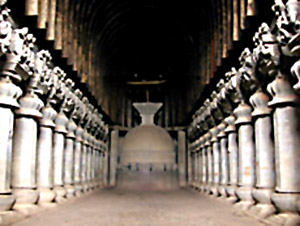The sculpture of Karle chaitya closely resembles the Buddhist chaitya halls. It is popular as the largest rock cut chaitya and due to the fact that the Ekvira Devi Mandir is located in front of it. The sculpture of Karle chaitya was made during 100-125 A.D. It is situated in the Pune, Maharashtra.
 The sculpture of Karle chaitya primarily comprises figurines and animal forms. The chaitya hall at Karle is apsidal while the central space is in the form of a nave like structure. This, in turn, is surrounded by an ambulatory. Besides the intricate sculptures there are inscriptions at Karle chaitya which are of great importance. These inscriptions belong to the Satavahanas and Western Kshaharatas. These have been carved out on the rocks in the verandah, pillars of the hall and the court.
The sculpture of Karle chaitya primarily comprises figurines and animal forms. The chaitya hall at Karle is apsidal while the central space is in the form of a nave like structure. This, in turn, is surrounded by an ambulatory. Besides the intricate sculptures there are inscriptions at Karle chaitya which are of great importance. These inscriptions belong to the Satavahanas and Western Kshaharatas. These have been carved out on the rocks in the verandah, pillars of the hall and the court.
The Karle chaitya is supposed to have been created out of a solid rock and measures around 124 feet in depth. Within the cave there are 37 octagonal pillars. Some of these exquisite pillars have figures of elephants kneeling on bell shaped bases. In place of the cell there is a huge stupa with a wooden umbrella on the top. At the entrance of the Karle chaitya there is a huge horse shoe. The chaitya hall has been sculpted in such a way that it appears to rest on the back of an elephant that has ivory tusks and is wearing metal ornaments. The sculpture of chaitya is thus interesting to explore.
The sculpture of Karle chaitya differs from the other Buddhist chaityas in only one aspect. The façade screen at Karle is made of teak wood. In ancient India the Karle chaitya was often used as a prayer hall.



















